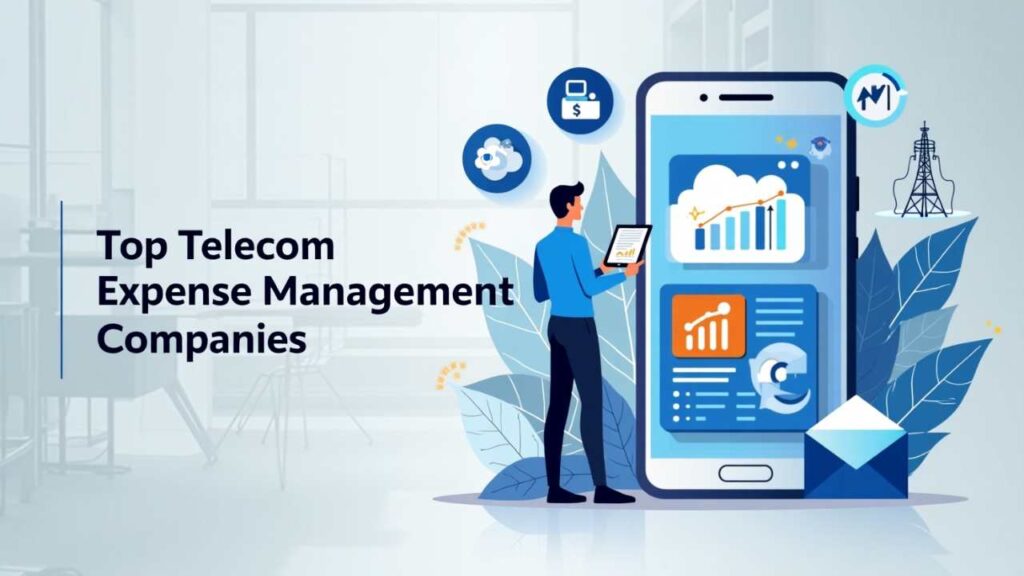With the modern world becoming a fast-paced digitalized environment, businesses rely more and more on telecommunications infrastructure in their operations, communication with clients, and to sustain growth. Nonetheless, this reliance is accompanied by the difficulty of dealing with multiple cutting-edge telecom factors that could swiftly run off track if not taken care of appropriately. Telecom Expense Management Companies are valuable to any business that wants to maximize its communication expenses as well as incur minimal running expenses.
With the introduction of 5G networks, IoT devices, and cloud-based communication services, the telecommunications industry has changed dramatically. Such technologies have opened a new avenue of saving costs, but have also brought a lot of complexity to the management of expenses. Duties of professional Expense Management Companies are needed more than ever as organisations find it difficult to handle the numerous vendors, deals, and billing arrangements.
What Is Telecom Expense Management (TEM)?
Telecom Expense Management (TEM) is the full-featured process of management, optimization, and control of telecommunications expenditures within the organization. It covers the lifecycle of telecom services, with procurement and provisioning as well as continuing monitoring and optimization. TEM solutions assist businesses with the visibility of their telecom expenditure, to detect the cost-reduction potential, to facilitate telecom-contract compliance, and regulatory compliance.
The main mission of TEM is to cut the expenses of telecommunications and enhance the quality of services and the efficiency of operations. This is attained by automating the processing of invoices, tracking of expenses, managing assets, and the provision of deep analytics that reveal insights on patterns of usage and expenditure trends. Modern TEM platforms combine with the existing enterprise systems and offer control and outcome of telecom costs in real-time.
One of the characteristics of TEM solutions is the inclusion of inventory management, contract lifecycle management, dispute management, and reporting. Centralizing telecom expense management allows an organization to avoid the pitfall of billing errors, get better deals with its providers, and base decisions involving its telecommunications infrastructure using data. The outcome is a major cost saving and an increase in working efficiency.
Why Your Business Needs a TEM Solution in 2025
Complex Multi-Vendor Environment Management
Big businesses today tend to have various telecommunication partners in various geographical locations and services. The TEM solutions offer central visibility and manageability of disparate vendor relationships, and it is simpler to administer contract management, price comparison, and consistency of service among all vendors.
Automated Invoice Processing and Error Detection
The manual invoice system is time-consuming and is bound to error,r, which may lead to excessive payments. TEM platforms automatically match invoices to contracts, detect cost errors and billing anomalies, indicate unusual costs, ensure correct payments, and save considerable amounts of money by eliminating errors.
Enhanced Cost Visibility and Analytics
In the absence of visibility, companies struggle to understand their actual telecom spending habits. Data-driven cost reduction involves the utilization of TEM solutions that offer extensive dashboards and analytics to display spending trends, how the organization uses the data, and possible ways to optimize all of this.
Compliance and Regulatory Management
The telecom world comes with rules and regulations of compliance, which may differ depending on the region or service being provided. By monitoring changes to the regulations, controlling and documenting, ensuring compliance with industry standards and internal policies, TEM platforms support compliance with businesses.
Scalability for Growing Organizations
With the increasing size of the businesses, their telecommunication requirements become more complicated. Solutions brought by TEMEnable platforms that are scalable and capable of supporting the larger organization as its services, locations, and technologies expand without dedicating new resources and management overhead.
Key Features to Look for in a TEM Provider
Real-Time Visibility and Reporting
A well-built TEM platform must give real-time views of telecom costs, consumption trends, and inventory of assets. The extensive reporting functions assist companies in understanding the level of their performance, establishing trends, and making accurate decisions regarding their telecommunications system and expenditure.
Automated Invoice Processing and Validation
Seek providers that will provide automated invoice processing, with in-built validation of contracts and rate schedules. This functionality differs from the manual one considerably as it saves manual work and guarantees the accuracy, as well as the possibility to detect possible errors in the entries of the bills or excess payments that would otherwise remain hidden.
Contract and Vendor Management
Proper TEM solutions must incorporate full scale contract lifecycle management such as storing of the contracts, tracking renewal of the contracts and performance of the vendor. This would guarantee the best contract conditions, and companies could sustain good relations with the service providers.
Integration with Existing Systems
The top TEM suppliers provide features that can easily be integrated with the rest of the enterprise system,m, including ERP, HR, and IT service management systems. This integration will provide data consistency, and there will be no need of having to manually enter data on numerous systems.
Mobile and Cloud-Based Accessibility
The contemporary TEM alternative must therefore be delivered via the mobile and on a cloud basis, supporting off-site access and control and employee management. This freedom is critical to distributed teams and multi-site organizations, and remote employees.
Top 10 Telecom Expense Management Companies in the U.S. 2025
1. Tangoe
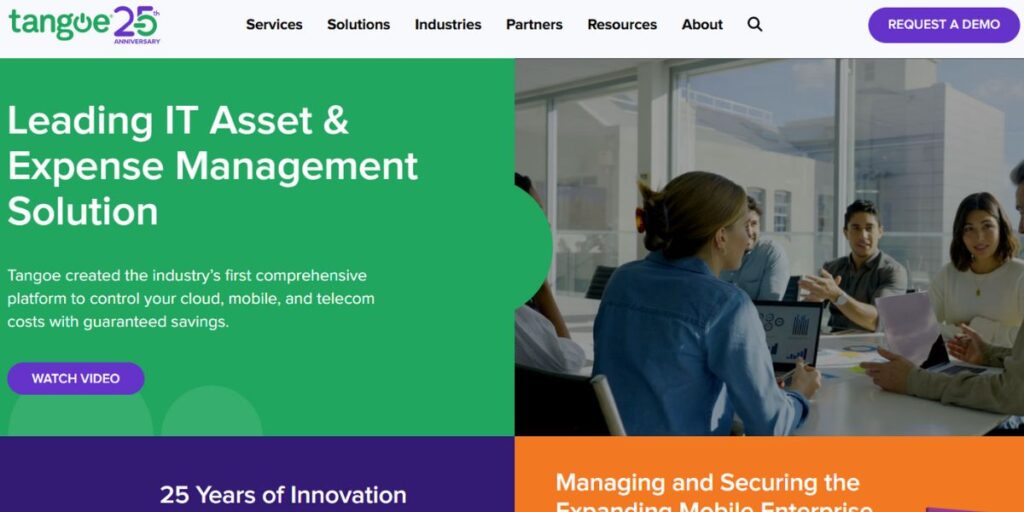
Headquarters: Indiana, United States
Website: http://tangoe.com
Ratings: 4.5/5
Team Size: 1,000+ employees
Tangoe is among the most prominent Telecom Expense Management Companies present in the United States, which deals with providing end-to-end expense management services that encompass telecom, cloud, and mobility services. Tangoe One is the flagship platform of the company, reflecting a complex interrelationship of the features of expense management, inventory tracking, and real-time analytics.
Tangoe has spent more than 20 years in the industry developing a reputation that aligns with the expectations of other businesses in terms of reducing technology expenditure and ensuring compliance under high standards. The solution being offered by the company is a combination of state-of-the-art technology, coupled with managed services expertise, offered by the company in order to achieve savings and increased operational efficiency for its customers belonging to multiple industries.
Key Services:
- Comprehensive expense management and optimization
- Real-time inventory tracking and asset management
- Contract lifecycle management and negotiation support
- Invoice auditing and dispute resolution services
- Managed services for complete telecom administration
Strengths: Analytics platform that possesses smooth integrations, flexibility, and a fully managed service.
Target Client: Large organizations and Fortune five hundred companies, which require end-to-end telecom expense management services.
Why Choose Tangoe: Successful history of providing large cost reductions with novel technology and managed services expertise.
2. Calero-MDSL
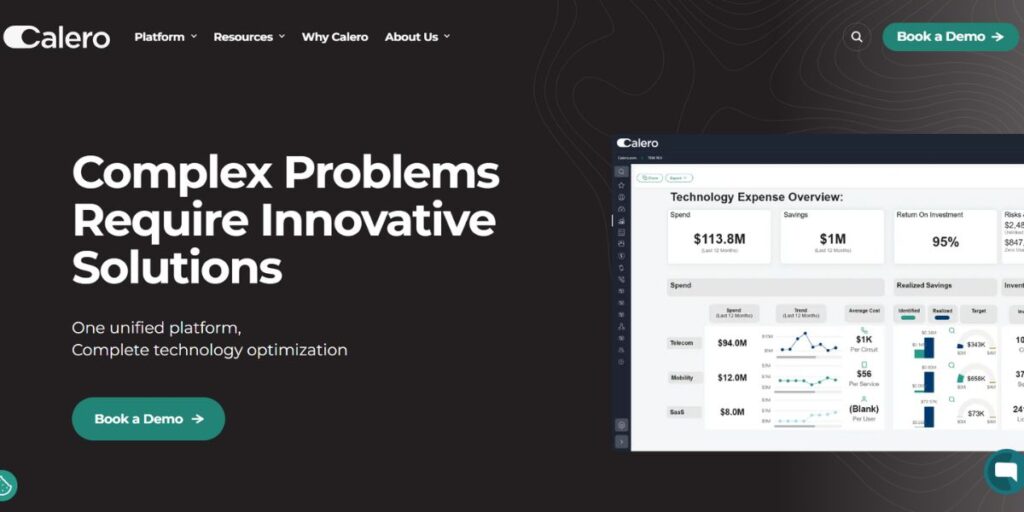
Headquarters: New York, United States
Website: https://www.calero.com/
Ratings: 4.3/5
Team Size: 800+ employees
Calero-MDSL is an embodiment of technology expense management industry knowledge, whereby the company has integrated the technology expense management capabilities and caters those enterprises with complicated requirements in telecom, cloud, and IT expenses. As one of the leading SaaS companies in India and beyond, its Software-as-a-Service (SaaS) platform offered by the company offers real-time views in cost of technologies against directable insights that help in cost optimization and operational efficiency.
Calero-MDSL has a high degree of concentration on serving the accounts with the Fortune 500 enterprise and government agencies which resulting in strong analytics and reporting functions that the Expense Management Companies has created, unlike other companies in this industry. The platform’s capability to support complex, multi-vendor environments is what makes it useful to large organizations with varied technology infrastructures and high costs associated with managing expenses.
Key Services:
- Unified technology expense management platform
- Real-time expense visibility and analytics
- Comprehensive reporting and dashboard capabilities
- Multi-vendor management and optimization
- Government and enterprise-focused solutions
Strengths: Powerful SaaS software that has integrations with high-level analytics that directly cater to Fortune 500 clients and government customers.
Target Client: Fortune 500 companies and government organizations that have complicated technology expense management requirements.
Why Choose Calero-MDSL: Expertise is in large organizations, serving with analytics and reporting, well-proven.
3. Sakon
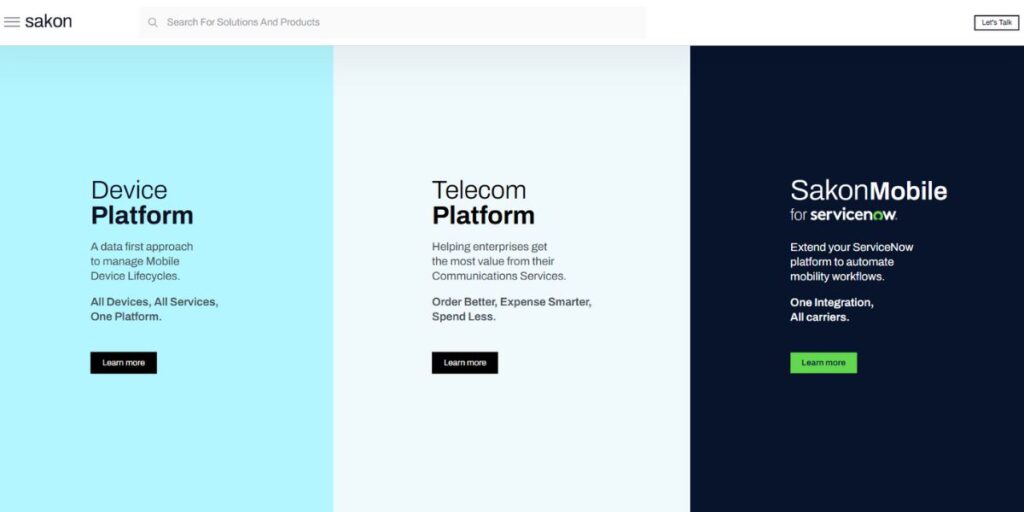
Headquarters: Massachusetts, United States
Website: http://sakon.com
Ratings: 4.2/5
Team Size: 200+ employees
Sakon is a telecom and IT expense management expert, especially dealing with mobility and lifecycle management tools. The platform used by the company offers complete insight into inventory and spending levels across worldwide operations in the telecommunications industry, which makes it a perfect solution to the needs of the organization with operations spread around the world and having complicated telecommunications needs related to its operations.
The difference between Sakon and other Telecom Expense Management Companies is that Sakon integrates itself into both Enterprise Resource Planning (ERP) and IT Service Management (ITSM) applications to facilitate an effortless workflow and data silo-free. The company has gained a lot of skills and experience in operating expenses, invoice auditing, and compliance monitoring, which has made it an organization of choice when it comes to streamlining the telecom-related operations of an organization with high levels of cost management and strict compliance with regulations.
Key Services:
- Telecom and IT expense management solutions
- Mobility and lifecycle management services
- Global inventory and spending visibility
- ERP and ITSM integration capabilities
- Expense optimization and compliance tracking
Strengths: Brings terrific ERP and ITSM integration and another specialization: mobility management.
Target Client: Multi-national companies that need the incorporation of telecommunications expenses management into business-in-use applications.
Why Choose Sakon: The possibility to integrate and remarkable integration capabilities, expert knowledge of mobility lifecycle management.
4. Avotus
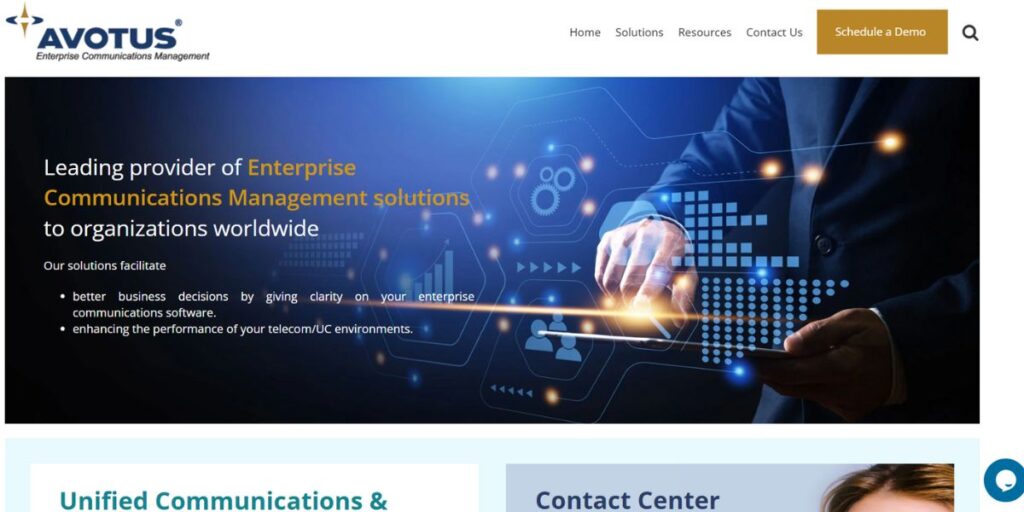
Headquarters: Ontario, Canada (with significant U.S. operations)
Website: http://avotus.com
Ratings: 4.1/5
Team Size: 150+ employees
Avotus provides an extensive portfolio of telecom expense and lifecycle management solutions and features that are used in providing a deep view and insight into the telecom assets, telecom purchasing, telecom invoicing, and usage analytics. The modular platform design used by the company enables corporations to customize solutions to suit their needs, thus making them more flexible and capable of fitting various needs in organizations.
The concentration on the automation of complex processes in Telecom and the strict observance of the industry regulations and internal rules defines Expense Management Companies avotus among others. The detailed telecom lifecycle management features of the platform, through procurement, disposal, et, provide the organization’s control over telecom infrastructure and cost completely.
Key Services:
- Comprehensive telecom expense management
- Lifecycle management solutions
- Automated process management and compliance
- Detailed usage analytics and reporting
- Modular platform design for customization
Strengths: Modular platform architecture that enables customized solutions to be supplied, as well as the ability to manage virtually the entire lifecycle.
Target Client: Medium to large firms with a need to get telecom expenses management solutions tailored to their needs.
Why Choose Avotus: Highly adaptable to the way you work.k Built up out of modules with powerful compliance and automation capability.
5. WidePoint
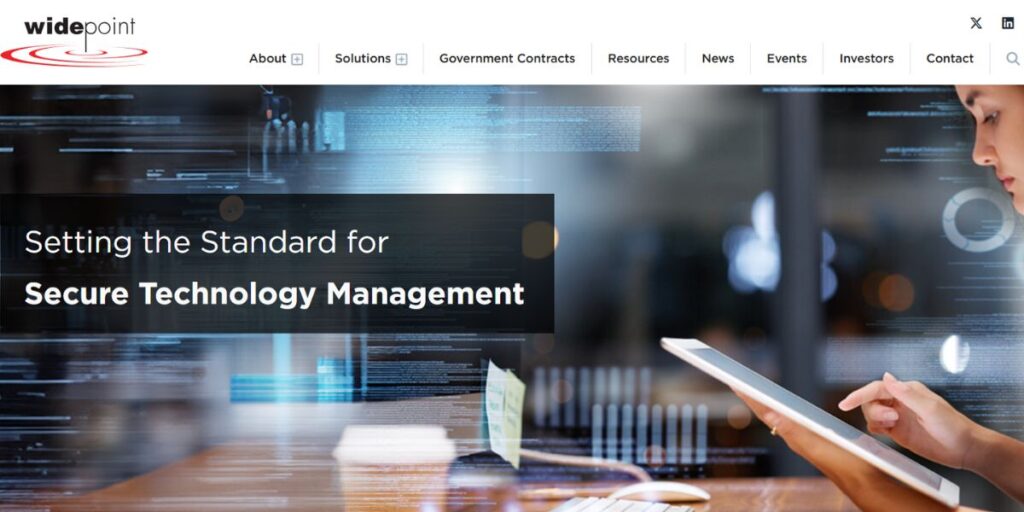
Headquarters: Fairfax, Virginia, United States
Website: http://widepoint.com
Ratings: 4.0/5
Team Size: 300+ employees
WidePoint focuses on secure technology management and telecom expense services with a special understanding of the management of mobile and wireless device costs and government corporations that have very high security needs. The TEM solution provided by this company has particular security characteristics that become of special interest to industries where the threats posed by the loss of information are high and adherence to the federal security requirements. Is required.
Whereas so many other Telecom Expense Management Companies are focused entirely on the business enterprise community, WidePoint, by providing its services to government and security-sensitive enterprises, has developed specialized bill validation capabilities as well as budget forecasting and compliance tracking capabilities to address the most challenging security and regulatory environments. The intricate knowledge of the government procurement systems and security measures in the company makes the company an excellent partner to the organization that has to work in highly confronting environments.
Key Services:
- Secure technology and telecom expense management
- Mobile and wireless device management
- Government-focused solutions and compliance
- Invoice validation and budget forecasting
- Security-enhanced expense tracking
Strengths: Niche security options and long-term work experience with government agencies and companies with a high level of security requirements.
Target Client: Governmental organizations and businesses that have rigorous safety and compliance standards.
Why Choose WidePoint: Its security levels are unparalleled, and they have demonstrated experience in educational as well as high-security areas.
6. brightfin
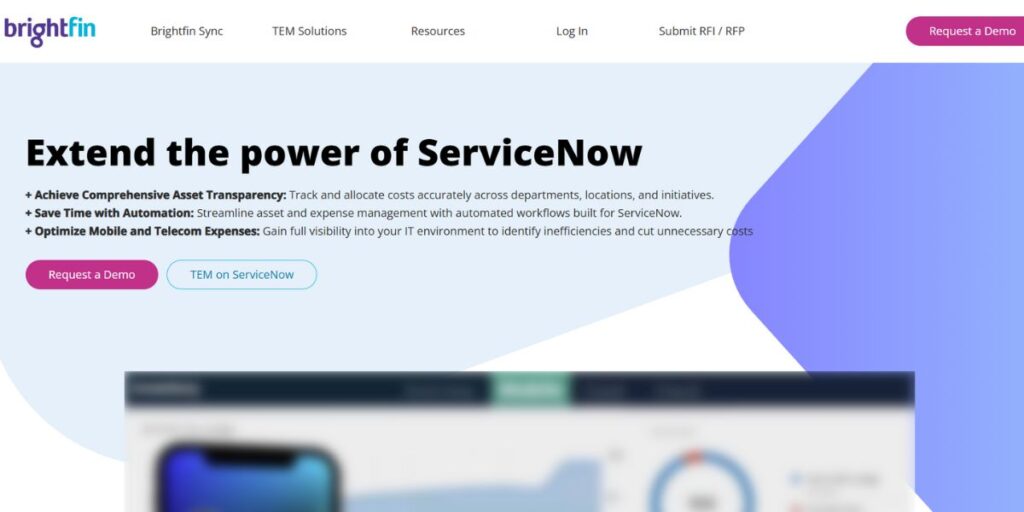
Headquarters: California, United States
Website: http://brightfin.com
Ratings: 4.2/5
Team Size: 100+ employees
Brightfin is a result of the successful acquisition of MobiChord, Mobile Solutions, and Visage, which is a combined technology expense management platform that uses the ServiceNow platform. With strategic convergence, this has produced one of the most inventive Expense Management Companies in the market that has full-scale solutions to mobile device management (MDM), tracking in telecom expenses, and IT asset management.
The provision of a cloud-based platform that can automate processes and minimize the expenses of business operations via intelligent automation can be considered as one of the strengths of the company. Unlike traditional TEM, Brightfin also takes a forward leap in technology expense management that leverages the power of automation and integration on advanced workflows that reduce manual efforts and offer better operational efficiency throughout the technology lifecycle.
Key Services:
- Unified technology expense management on ServiceNow
- Mobile Device Management (MDM) solutions
- IT asset management and tracking
- Workflow automation and integration
- Cloud-native platform capabilities
Strengths: Blast-resistant platform that has outstanding workflow automation and ServiceNow connector features.
Target Client: Businesses that use the ServiceNow platform and want to have their technology expenses managed effectively.
Why Choose Brightfin: The best automation options and integration with ServiceNow to operate more easily.
7. vCom
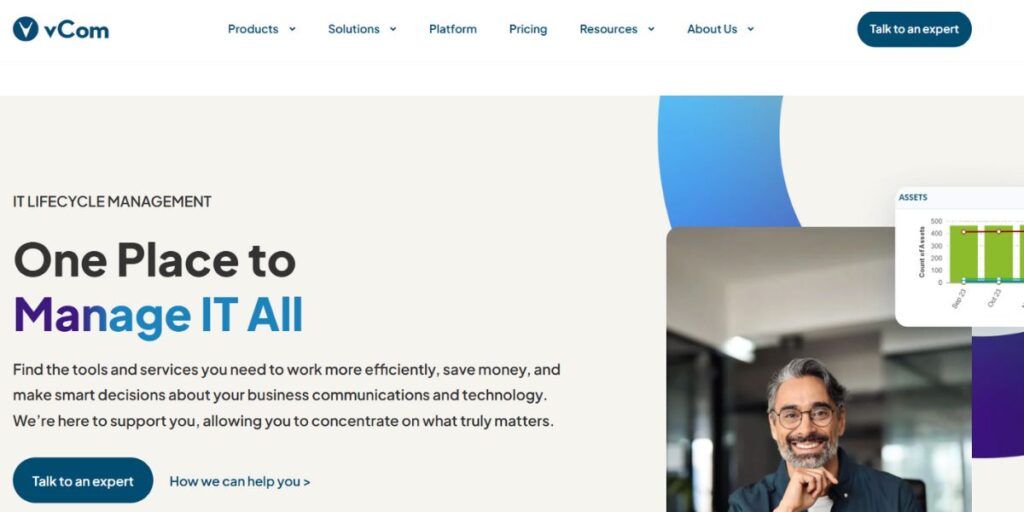
Headquarters: California, United States
Website: http://vcomsolutions.com
Ratings: 4.1/5
Team Size: 250+ employees
vManager is the TEM platform developed by vCom, a cloud-based, comprehensive solution that allows focusing on IT and telecom expenses management using a single and intuitive interface. The telecom expense management strategy of the company is to reduce the complexity of procedures like procurement, inventory application, on as well as managing the vendor, so that organizations can easily track their telecommunications expense.
The difference between vCom and other Telecom Expense Management Companies is that the company focuses on delivering a single interface where all telecom-related activities can take place, powerfully supported by the ability to report and audit invoices in real-time. The design of the platform guarantees the control of the cost, the non-miss of the contract provision, and the flexibility required to modify according to the incoming business needs in different industries.
Key Services:
- Cloud-based centralized expense management
- Procurement and inventory management
- Vendor coordination and relationship management
- Real-time reporting and invoice auditing
- Contract compliance and cost control
Strengths: Integrated interface design and extensive real-time reporting capability, and good vendor management.
Target Client: The mid-market to large organization focused on telecom expense management solutions.
Why Choose vCom: Streamlined, consolidated telecom management system with high levels of real-time integration; TEM.
8. Upland Cimpl
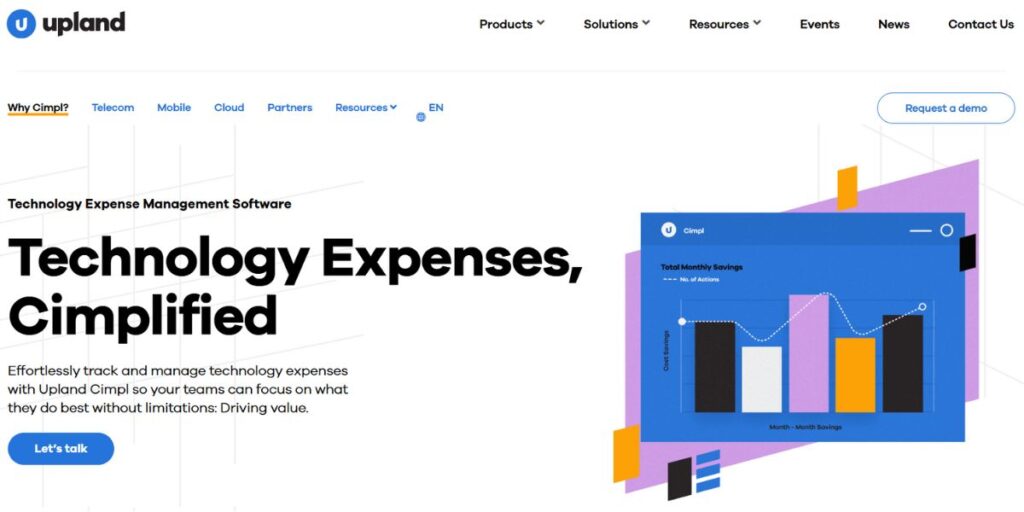
Headquarters: Massachusetts, United States
Website: https://uplandsoftware.com/cimpl/
Ratings: 4.3/5
Team Size: 500+ employees
Cimpl forms as a part of Upland Software, which is a powerful tool designed to address the complex requirements of large enterprises that operate in as many countries as possible. This complex cost allocation management, automatic tracking of the expense, and high-level analytics have contributed to the fact that it is one of the most complete Telecom Expense Management Companies for global corporations.
The solutions offered by Upland Cimpl are especially appreciated due to their capability to manage complicated multination telecom operations that are characterized by several currencies, regulations, and vendors. The next level of analytics support offered by the platform offers great insights into the spending trends and optimization potential, which allows large companies to experience terrific cost savings and continue to operate efficiently across the geographical regions.
Key Services:
- Enterprise-grade cost allocation management
- Automated expense tracking and analytics
- Multinational telecom environment management
- Advanced analytics and reporting capabilities
- Global compliance and regulatory support
Strengths: Outstanding demonstrated abilities dealing with multinational telecom complexities through high-grade analytics.
Target Client: Multinational corporations and large enterprises that have complicated telecom needs on an international level.
Why Choose Upland Cimpl: Capabilities unsurpassed in controlling multinational, complicated telecom environments through advanced analytics.
9. Orange Business
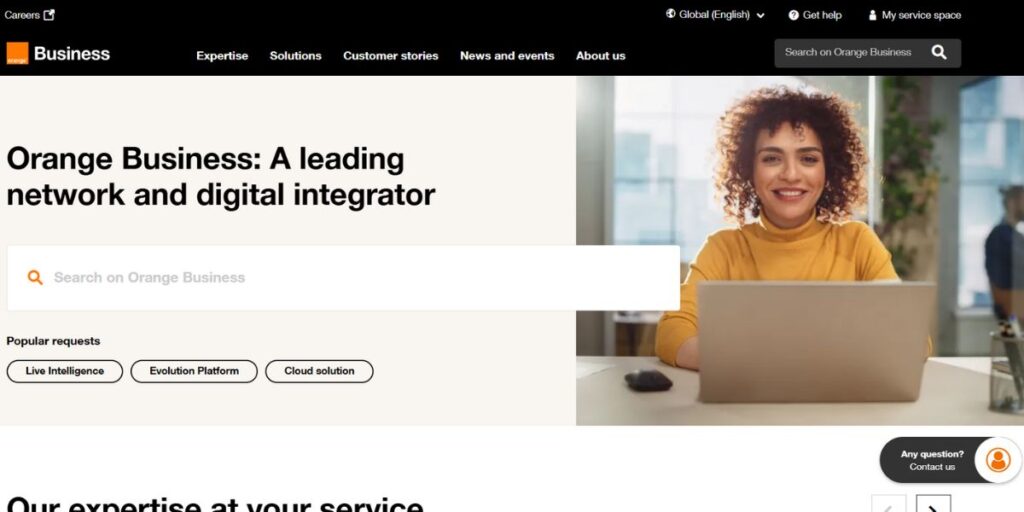
Headquarters: Prais, France
Website: https://www.orange-business.com/en
Ratings: 4.0/5
Team Size: 80+ employees
Orange Business is a specialist provider of managed TEM services focused on the mid-size and enterprise business and operating based on minimising operational inefficiencies and increasing financial transparency. The company’s strategy on Telecom expense management focuses on a hands-on service delivery process that is comprehensive in terms of the inventory, in-depth audit of the bills, and preemptive dispute resolutions.
Orange Business is one of the Expense Management Companies that has won praise because of its commitment to making a complex telecom expense process, but on the other hand has high rates of customer service and customer support. Managed services methodology enables the clients to concentrate on the central business processes, as the complexities of telecom handling, vendor handling of vendors, and cost-cutting efforts are taken up by the Orange Business Services.
Key Services:
- Managed TEM services and support
- Comprehensive inventory management
- Detailed bill auditing and validation
- Proactive dispute resolution services
- Financial visibility and cost optimization
Strengths: High managed services strategy with exclusive emphasis on operational or customer service.
Target Client: Mid to large corporations who want enterprise-grade managed telecom expense management, accompanied by personal attention.
Why Choose Network Control: Tailored managed services delivery model, customer support, and operational efficiency oriented.
10. CGI
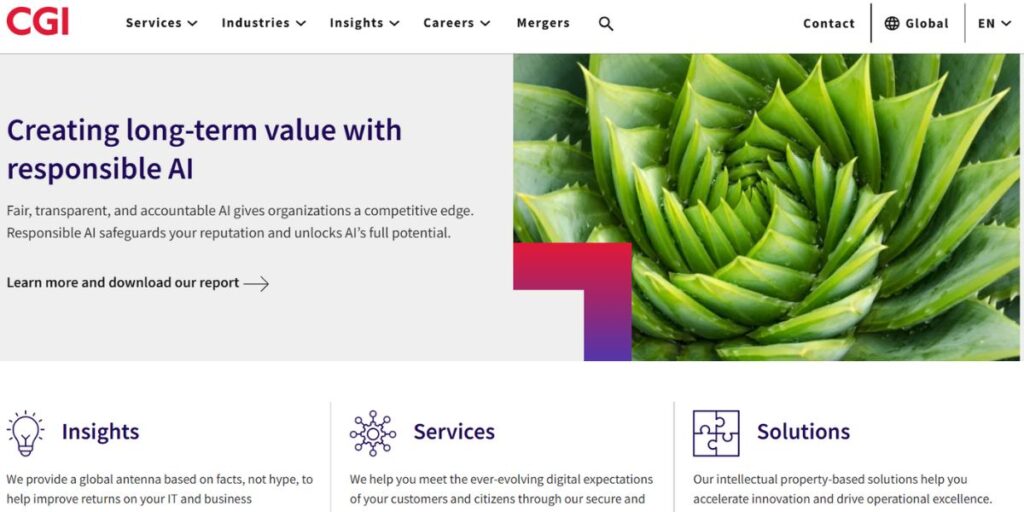
Headquarters: Montreal, Canada (with extensive U.S. operations)
Website: http://cgi.com
Ratings: 4.2/5
Team Size: 90,000+ employees globally
CGI brings its vast IT consulting experience together with the management of the telecom expenses and provides a full scope of integrated management of telecom and IT expenses. Being among the largest Telecom Expense Management Companies with an international presence, CGI makes use of its large pool of consultants and technology professionals to offer tailor-made solutions depending on the needs of the client.
This platform of the company focuses on efficiencies and transparency, and helps organizations to have control of their whole telecom lifecycle, and, at the same time, enjoy the wider IT consulting services offered by CGI. This is a comprehensive model that enables the clients to treat telecom expense management as their general IT strategy, as it aligns with the business’s goals and technology roadmaps.
Key Services:
- Integrated IT and telecom expense management
- Comprehensive consulting and advisory services
- Telecom lifecycle management solutions
- Customized platform development and implementation
- Global support and service delivery
Strengths: High levels of consulting experience along with in-built IT and telecommunication cost management facilities.
Target Client: Large businesses that want to have integrated IT and telecom expense management on top of the entire consulting services.
Why Choose CGI: Broad consulting knowledge base and worldwide presence, and facilities to do IT/telecom management, also integrated.
How to Choose the Right Telecom Expense Management Companies for Your Business
1. Assess Your Organization’s Complexity and Scale
When interviewing providers, inform them of the size of your organization, the number of locations, and your telecom environment complexity. The big companies, whose activities span across the globe, will need a more complex platform with comprehensive analytics, whereas the smaller ones could use less complex models that prioritize basic expense management functions.
2. Evaluate Integration Capabilities with Existing Systems
Find out whether or not the TEM provider can connect with your existing enterprise systems, such as ERP, human resources, as well as IT service management systems. When properly integrated, data silos will have been removed, there will be less manual data entry, and a persistent flow of information across all of the business systems thereby enhancing the operative effectiveness and information quality.
3. Consider Security and Compliance Requirements
Examine the security settings, the audits, where the provider is in compliance with the requirements, and the possibility that they can serve your specific regulatory requirements. If an organization belongs to a very regulated industry or deals with sensitive data, it is important that the provider has strong security processes, audit trails, and a history of compliance.
4. Analyze Total Cost of Ownership and ROI Potential
Look beyond the installation costs to include ongoing and monthly fees, maintenance fees, and even return on investment. The top TEM vendors must be capable of showing tangible cost savings over the total cost of ownership, usually by identifying billing errors, contract management, compliance, and operational efficiency.
5. Review Support Services and Implementation Approach
Evaluate the implementation approach, training, and support services offered by the provider. To get a successful implementation of TE, M, there must be good change management, training of users, and support to help the user realize maximum benefit and adoption of TEM in your whole organization.
Conclusion
The Telecom Expense Management Companies landscape in 2025 indicates the increasing complexity and the significance of the telecommunications cost management to current business functionality. Driving the digitization of organizations, 5G networks, and IoT solutions, the demand to have advanced expense management solutions is higher than ever. The best solutions to these challenges presented in the field of telecom expense management feature the top 10 Expense Management Companies that are illuminated in this article.
The future of telecom expense management will probably involve further innovation and automation, in addition to artificial intelligence and predictive analysis, as these firms attempt to provide even more value to their customers. The evolution of telecommunication industries will be an important way of attracting competitive advantage toward operations and efficiency in a highly interconnected world; hence, collaboration with the appropriate TEM provider will be critical.
Frequently Asked Questions
What is the average cost savings organizations can expect from implementing a TEM solution?
Implementation of TEM usually results in 15-30 percent savings in telecommunications costs of organizations. These savings are in the form of detection of billing errors, contract optimization, eradication of unused services, and enhanced negotiations with vendors. It will be determined by the level of maturity of the expenses management process within the specific organization and the complexity of its telecom environment.
How long does it typically take to implement a TEM solution?
The timelines of different implementations are based on the size and complexity of individual organizations, although the vast majority of TEM implementations require 3-6 months to be fully implemented. This involves the migration of data, integration of the system, training the user, and optimization of the processes. The smaller organizations can find quicker implementation, and the big enterprises with a complex environment may need substantial implementation time.
Can Telecom Expense Management Companies integrate with existing ERP and financial systems?
Yes, contemporary TEM solutions are devised to interface with commonly used ERP systems, such as SAP, Oracle, and Microsoft Dynamics, and financial management systems. Such integrations differ according to the smooth flow of data, no data redundancy among data entries, and consolidated reporting of all business systems.
What types of telecommunications expenses can be managed through TEM platforms?
The types of expenses that TEM platforms can operate encompass mobile devices, and services as well as the landline phone, internet, data circuits, cloud communications, IoT devices connectivity, and international calling services. The other costs tied to these IDs, such as equipment acquisition, maintenance contracts, and professional services, are also dealt with by most platforms.
How do TEM providers ensure data security and compliance?
The major TEM providers deployed strong security options such as data encryption, secure data centers, access controls, and frequent security reviews. They also ensure that they meet the industry requirements like SOC 2, ISO 2700,1, and GDPR. The providers have many specialized compliance capabilities that suit regulated industries such as finance, healthcare, and government.
